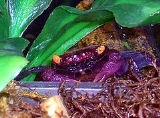
Geosesarma
Encyclopedia
Geosesarma is genus of terrestrial crabs
. They live and reproduce on land with the larval stages
inside the egg
. Some species such as Geosesarma nemesis are insectivorous and are beneficial to humans. Some species are kept as pets. They were once considered part of the Grapsidae
family but were moved out with the other Sesarmidae
. Most species of this genus are brightly coloured.
Geosesarma contains the following species:
Land crab
Gecarcinidae is a family of true crabs that are adapted for terrestrial existence, commonly known as land crabs. Similar to all other crabs, land crabs possess a series of gills. In addition, the part of the carapace covering the gills is inflated and equipped with blood vessels. These organs...
. They live and reproduce on land with the larval stages
Crustacean larvae
Crustaceans may pass through a number of larval and immature stages between hatching from their eggs and reaching their adult form. Each of the stages is separated by a moult, in which the hard exoskeleton is shed to allow the animal to grow...
inside the egg
Egg (biology)
An egg is an organic vessel in which an embryo first begins to develop. In most birds, reptiles, insects, molluscs, fish, and monotremes, an egg is the zygote, resulting from fertilization of the ovum, which is expelled from the body and permitted to develop outside the body until the developing...
. Some species such as Geosesarma nemesis are insectivorous and are beneficial to humans. Some species are kept as pets. They were once considered part of the Grapsidae
Grapsidae
Grapsidae is a family of crabs known variously as marsh crabs, shore crabs or talon crabs. It is not confirmed that the family forms a monophyletic group and some taxa may belong in other families...
family but were moved out with the other Sesarmidae
Sesarmidae
Sesarmidae is a family of crabs, previously included in the Grapsidae by many authors. Several species, namely in Geosesarma, Metopaulias and Sesarma, are true terrestrial crabs. They do not need to return to the sea even for breeding.-Genera:...
. Most species of this genus are brightly coloured.
Geosesarma contains the following species:
- Geosesarma albomita Yeo & Ng, 1999
- Geosesarma amphinome (De Man, 1899)
- Geosesarma angustifrons (A. Milne-Edwards, 1869)
- Geosesarma araneum (Nobili, 1899)
- Geosesarma aurantium Ng, 1995
- Geosesarma bau Ng & Jongkar, 2004
- Geosesarma bicolor Ng & Davie, 1995
- Geosesarma cataracta Ng, 1986
- Geosesarma celebense (Schenkel, 1902)
- Geosesarma clavicrure (Schenkel, 1902)
- Geosesarma confertum (Ortmann, 1894)
- Geosesarma danumense Ng, 2003
- Geosesarma foxi (Kemp, 1918)
- Geosesarma gordonae (Serène, 1968)
- Geosesarma gracillimum (De Man, 1902)
- Geosesarma hednon Ng, Liu & Schubart, 2003
- Geosesarma ianthina Pretzmann, 1985
- Geosesarma insulare Ng, 1986
- Geosesarma johnsoni (Serène, 1968)
- Geosesarma katibas Ng, 1995
- Geosesarma krathing Ng & Naiyanetr, 1992
- Geosesarma lawrencei Manuel-Santos & Yeo, 2007
- Geosesarma leprosum (Schenkel, 1902)
- Geosesarma maculatum (De Man, 1892)
- Geosesarma malayanumGeosesarma malayanumGeosesarma malayanum is a species of small red crab which is found in Malaysia. It is famous for its relationship with pitcher plants: as such, it is classified as a nepenthephile. G. malayanum is known to visit Nepenthes ampullaria plants and raid the pitchers of their contents. It uses its claws...
Ng & Lim, 1986 - Geosesarma nannophyes (De Man, 1885)
- Geosesarma nemesis Ng, 1986
- Geosesarma noduliferum (De Man, 1892)
- Geosesarma notophorum Ng & C. G. S. Tan, 1995
- Geosesarma ocypodum (Nobili, 1899)
- Geosesarma penangense (Tweedie, 1940)
- Geosesarma peraccae (Nobili, 1903)
- Geosesarma protos Ng & Takeda, 1992
- Geosesarma rathbunae (Serène, 1968)
- Geosesarma rouxi (Serène, 1968)
- Geosesarma sabanum Ng, 1992
- Geosesarma sarawakense (Serène, 1968)
- Geosesarma scandens Ng, 1986
- Geosesarma serenei Ng, 1986
- Geosesarma solomonense (Serène, 1968)
- Geosesarma starmuhlneri Pretzmann, 1984
- Geosesarma sumatraense Ng, 1986
- Geosesarma sylvicola (De Man, 1892)
- Geosesarma ternatense (Serène, 1968)
- Geosesarma teschi Ng, 1986
- Geosesarma thelxinoe (De Man, 1908)
- Geosesarma tiomanicum Ng, 1986
- Geosesarma vicentense (Rathbun, 1914)

